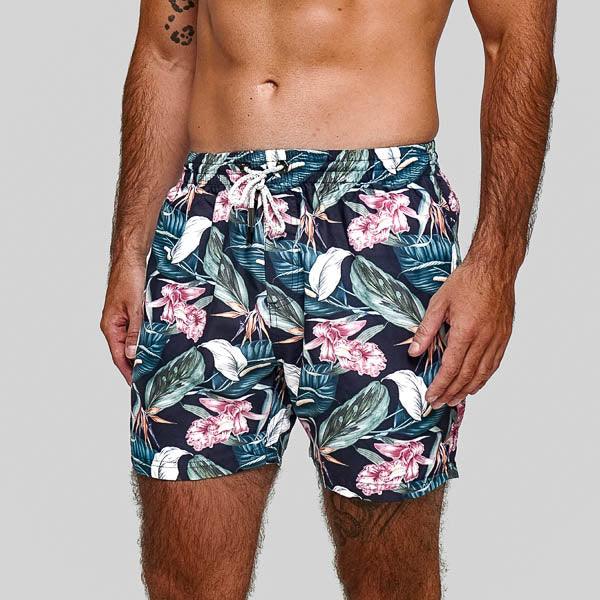With increasing awareness of environmental issues, many people are opting for eco-friendly swimwear. But how can you tell if your men’s swim trunks are truly sustainable? This guide will explore the key indicators of eco-friendly swim trunks, helping you make informed choices that benefit both you and the planet.
1. Examine the Fabric
Recycled Materials
Eco-friendly swim trunks often use recycled materials, such as polyester from post-consumer plastic bottles or discarded fishing nets. These fabrics reduce waste and lower the carbon footprint of production.
- Look for labels indicating the use of recycled polyester (rPET) or nylon (Econyl).
- Benefits: Reduces plastic waste and conserves resources.
Organic Fibers
Some sustainable swim trunks incorporate organic fibers like cotton or hemp, grown without synthetic pesticides or fertilizers. These materials are biodegradable and have a lower environmental impact.
- Check for certifications like GOTS (Global Organic Textile Standard) for organic cotton.
- Benefits: Eco-friendly farming practices and lower environmental impact.
2. Assess the Dyeing Process
Low-Impact Dyes
Eco-friendly swim trunks use low-impact dyes that require less water and energy, resulting in minimal pollution. These dyes are less harmful to the environment and human health.
- Look for terms like “azo-free” or “low-impact” dyes.
- Benefits: Reduced water usage and fewer harmful chemicals.
Natural Dyes
Some brands use natural dyes made from plants or minerals. These dyes are biodegradable and non-toxic, making them a safer option for both the environment and the wearer.
- Look for labels indicating the use of natural dyes.
- Benefits: Non-toxic and biodegradable, reducing environmental impact.
3. Evaluate the Manufacturing Process
Ethical Production
Eco-friendly swim trunks are often produced under ethical working conditions, ensuring fair wages and safe environments for workers.
- Check the brand’s transparency about their labor practices.
- Benefits: Supports fair labor and ethical practices in the fashion industry.
Energy and Water Efficiency
Sustainable brands often implement energy and water-saving practices during production. This includes using renewable energy sources and minimizing water waste.
- Look for information on the brand’s sustainability practices.
- Benefits: Reduced carbon footprint and resource conservation.
4. Consider the Packaging
Minimalist Packaging
Eco-friendly brands use minimal, recyclable, or biodegradable packaging to reduce waste. Look for packaging that aligns with sustainable practices, such as compostable bags or recycled paper tags.
- Check for packaging details on the product or brand website.
- Benefits: Reduces waste and environmental impact.
Reusable Packaging
Some brands offer reusable packaging, such as fabric bags or pouches, which can be used for storage or travel.
- Look for mentions of reusable packaging options.
- Benefits: Reduces single-use packaging waste.
5. Look for Certifications
Global Recycled Standard (GRS)
This certification ensures that the product contains recycled materials and meets environmental and social criteria.
- Check for the GRS label on the swim trunks.
- Benefits: Guarantees the use of recycled materials and sustainable practices.
OEKO-TEX Standard 100
This certification indicates that the fabric is free from harmful chemicals, ensuring safe and sustainable production processes.
- Look for the OEKO-TEX label on the product.
- Benefits: Ensures safe and eco-friendly textile production.
6. Research the Brand
Brand Transparency
Eco-friendly brands are transparent about their sustainability efforts, providing detailed information on their website about materials, manufacturing processes, and ethical practices.
- Visit the brand’s website to learn about their sustainability initiatives.
- Benefits: Informed purchasing decisions and support for responsible brands.
Customer Reviews
Read customer reviews to gain insights into the swim trunks’ quality, comfort, and sustainability. Look for reviews that mention eco-friendly features or the brand’s commitment to sustainability.
- Check review platforms and the brand’s website for feedback.
- Benefits: Real-life experiences and insights into product quality.
Conclusion
Determining if your men’s swim trunks are eco-friendly involves examining the fabric, dyeing process, manufacturing practices, packaging, and brand transparency. By looking for recycled materials, ethical production, and sustainable certifications, you can make informed choices that support both environmental and social responsibility. Choose eco-friendly swim trunks to enjoy the benefits of stylish, comfortable swimwear while contributing to a healthier planet. Check out more information in our other guides to sustainable mens swiwmear.
FAQs
1. What fabrics are used in eco-friendly swim trunks?
- Eco-friendly swim trunks often use recycled materials like rPET and Econyl, or organic fibers such as cotton and hemp.
2. How can I tell if the dyeing process is eco-friendly?
- Look for terms like “low-impact” or “natural dyes,” which indicate environmentally friendly dyeing practices.
3. Why is ethical production important in eco-friendly swimwear?
- Ethical production ensures fair labor practices and safe working conditions, supporting social responsibility in the fashion industry.
4. What certifications indicate eco-friendly swim trunks?
- Certifications like Global Recycled Standard (GRS) and OEKO-TEX Standard 100 indicate sustainable and safe production practices.
5. How does eco-friendly packaging benefit the environment?
- Minimalist and reusable packaging reduces waste and environmental impact, aligning with sustainable practices.
6. Why is brand transparency important when choosing eco-friendly swimwear?
- Transparent brands provide detailed information about their sustainability efforts, allowing consumers to make informed, responsible choices.



















